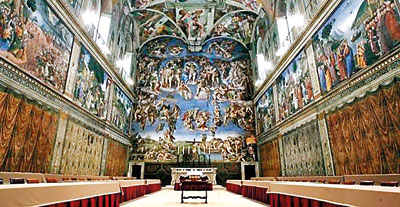Sunday Times 2
Vatican in bid to protect Michelangelo frescoes
View(s):VATICAN CITY (Reuters) – The Vatican has unveiled new high-tech, energy-saving lighting and air purification systems to protect Michelangelo’s delicate Sistine Chapel frescoes from damage caused by ever-growing crowds of tourists.

Newly installed tables stand under Michaelangelo's frescoes in the Vatican's Sistine Chapel (Reuters)
Dust brought in from outside, body sweat and carbon dioxide pose a major risk to the masterpieces, which are more than 500 years old. They include one of the most famous scenes in the history of art – the arm of a gentle bearded God reaching out to give life to Adam.
To protect the frescoes, the Vatican has decided to restrict the number of visitors to the chapel – where popes are elected in secret conclaves – to 6 million a year.
The previous lighting and air conditioning systems were installed in 1994 – when the number of visitors stood at about 1.5 million – and had become inadequate to protect the work of the Renaissance master.
The new air filtering and conditioning system, which is virtually invisible to visitors and uses pre-existing duct openings, moves air at a very slow speed so as not to damage the frescoes.
Hidden cameras, including two on the massive Last Judgement panel behind the altar, check the number people while some 70 monitors control machines outside the chapel that determine air flow, filter out dust and reduce humidity.
“This chapel is a unique structure so we spent a great deal of time understanding how air flows here in order to map the technology,” said John Mandyck, chief sustainability officer for United Technologies unit Carrier, which developed the system.
“Air flows differently here than it does, say in an office building or even another church,” he told reporters during a evening presentation after the Vatican Museums had closed for the day to tourists.
The new lighting system, made by Germany’s Osram uses some 7,000 LED (light emitting diode) lamps consuming up to 90 percent less electricity than previously, reducing heat to further protect the frescoes.
It has three levels of lighting. One very low level will be used when the chapel is empty, a medium level of illumination will be used when the chapel is open to tourists and a third, much brighter and hotter level will be used only several times a year during papal ceremonies.

